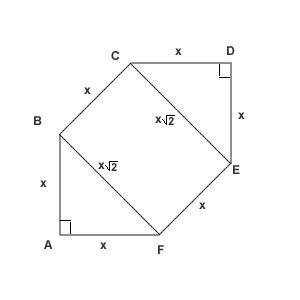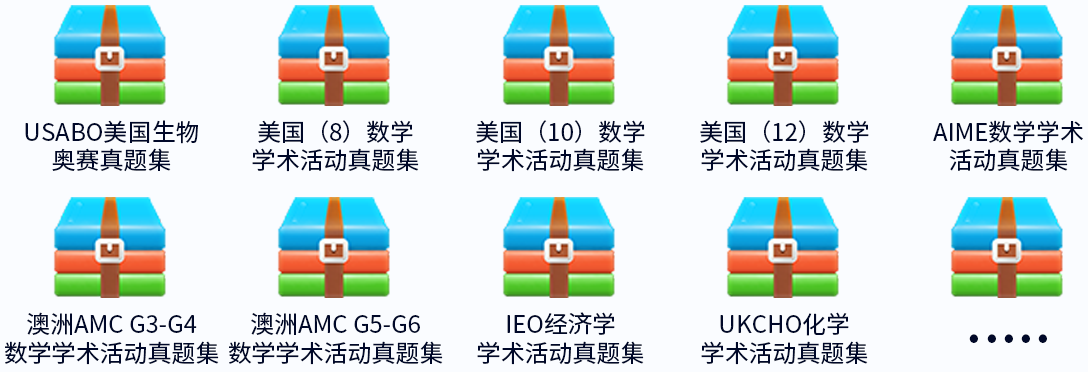- 翰林提供学术活动、国际课程、科研项目一站式留学背景提升服务!
- 400 888 0080
2006AIME II真题及答案解析
2006AIME II真题及答案解析
答案解析请参考文末
Problem 1
In convex hexagon ![]() , all six sides are congruent,
, all six sides are congruent, ![]() and
and ![]() are right angles, and
are right angles, and ![]() and
and ![]() are congruent. The area of the hexagonal region is
are congruent. The area of the hexagonal region is ![]() Find
Find ![]() .
.
Problem 2
The lengths of the sides of a triangle with positive area are ![]() ,
, ![]() , and
, and ![]() , where
, where ![]() is a positive integer. Find the number of possible values for
is a positive integer. Find the number of possible values for ![]() .
.
Problem 3
Let ![]() be the product of the first 100 positive odd integers. Find the largest integer
be the product of the first 100 positive odd integers. Find the largest integer ![]() such that
such that ![]() is divisible by
is divisible by ![]() .
.
Problem 4
Let ![]() be a permutation of
be a permutation of ![]() for which
for which
Problem 5
When rolling a certain unfair six-sided die with faces numbered 1, 2, 3, 4, 5, and 6, the probability of obtaining face ![]() is greater than 1/6, the probability of obtaining the face opposite is less than 1/6, the probability of obtaining any one of the other four faces is 1/6, and the sum of the numbers on opposite faces is 7. When two such dice are rolled, the probability of obtaining a sum of 7 is 47/288. Given that the probability of obtaining face
is greater than 1/6, the probability of obtaining the face opposite is less than 1/6, the probability of obtaining any one of the other four faces is 1/6, and the sum of the numbers on opposite faces is 7. When two such dice are rolled, the probability of obtaining a sum of 7 is 47/288. Given that the probability of obtaining face ![]() is
is ![]() where
where ![]() and
and ![]() are relatively prime positive integers, find
are relatively prime positive integers, find ![]()
Problem 6
Square ![]() has sides of length 1. Points
has sides of length 1. Points ![]() and
and ![]() are on
are on ![]() and
and ![]() respectively, so that
respectively, so that ![]() is equilateral. A square with vertex
is equilateral. A square with vertex ![]() has sides that are parallel to those of
has sides that are parallel to those of ![]() and a vertex on
and a vertex on ![]() The length of a side of this smaller square is
The length of a side of this smaller square is ![]() where
where ![]() and
and ![]() are positive integers and
are positive integers and ![]() is not divisible by the square of any prime. Find
is not divisible by the square of any prime. Find ![]()
Problem 7
Find the number of ordered pairs of positive integers ![]() such that
such that ![]() and neither
and neither ![]() nor
nor ![]() has a zero digit.
has a zero digit.
Problem 8
There is an unlimited supply of congruent equilateral triangles made of colored paper. Each triangle is a solid color with the same color on both sides of the paper. A large equilateral triangle is constructed from four of these paper triangles. Two large triangles are considered distinguishable if it is not possible to place one on the other, using translations, rotations, and/or reflections, so that their corresponding small triangles are of the same color.
Given that there are six different colors of triangles from which to choose, how many distinguishable large equilateral triangles may be formed?![[asy] size(50); pair A,B; A=(0,0); B=(2,0); pair C=rotate(60,A)*B; pair D, E, F; D = (1,0); E=rotate(60,A)*D; F=rotate(60,C)*E; draw(C--A--B--cycle); draw(D--E--F--cycle); [/asy]](https://latex.artofproblemsolving.com/1/1/d/11d5abd7384d03c423da478807ee2c6f2a5dfada.png)
Problem 9
Circles ![]() and
and ![]() have their centers at (0,0), (12,0), and (24,0), and have radii 1, 2, and 4, respectively. Line
have their centers at (0,0), (12,0), and (24,0), and have radii 1, 2, and 4, respectively. Line ![]() is a common internal tangent to
is a common internal tangent to ![]() and
and ![]() and has a positive slope, and line
and has a positive slope, and line ![]() is a common internal tangent to
is a common internal tangent to ![]() and
and ![]() and has a negative slope. Given that lines
and has a negative slope. Given that lines ![]() and
and ![]() intersect at
intersect at ![]() and that
and that ![]() where
where ![]() and
and ![]() are positive integers and
are positive integers and ![]() is not divisible by the square of any prime, find
is not divisible by the square of any prime, find ![]()
Problem 10
Seven teams play a soccer tournament in which each team plays every other team exactly once. No ties occur, each team has a ![]() chance of winning each game it plays, and the outcomes of the games are independent. In each game, the winner is awarded a point and the loser gets 0 points. The total points are accumulated to decide the ranks of the teams. In the first game of the tournament, team
chance of winning each game it plays, and the outcomes of the games are independent. In each game, the winner is awarded a point and the loser gets 0 points. The total points are accumulated to decide the ranks of the teams. In the first game of the tournament, team ![]() beats team
beats team ![]() The probability that team
The probability that team ![]() finishes with more points than team
finishes with more points than team ![]() is
is ![]() where
where ![]() and
and ![]() are relatively prime positive integers. Find
are relatively prime positive integers. Find ![]()
Problem 11
A sequence is defined as follows ![]() and, for all positive integers
and, for all positive integers ![]() Given that
Given that ![]() and
and ![]() find the remainder when
find the remainder when ![]() is divided by 1000.
is divided by 1000.
Problem 12
Equilateral ![]() is inscribed in a circle of radius 2. Extend
is inscribed in a circle of radius 2. Extend ![]() through
through ![]() to point
to point ![]() so that
so that ![]() and extend
and extend ![]() through
through ![]() to point
to point ![]() so that
so that ![]() Through
Through ![]() draw a line
draw a line ![]() parallel to
parallel to ![]() and through
and through ![]() draw a line
draw a line ![]() parallel to
parallel to ![]() Let
Let ![]() be the intersection of
be the intersection of ![]() and
and ![]() Let
Let ![]() be the point on the circle that is collinear with
be the point on the circle that is collinear with ![]() and
and ![]() and distinct from
and distinct from ![]() Given that the area of
Given that the area of ![]() can be expressed in the form
can be expressed in the form ![]() where
where ![]() and
and ![]() are positive integers,
are positive integers, ![]() and
and ![]() are relatively prime, and
are relatively prime, and ![]() is not divisible by the square of any prime, find
is not divisible by the square of any prime, find ![]()
Problem 13
How many integers ![]() less than 1000 can be written as the sum of
less than 1000 can be written as the sum of ![]() consecutive positive odd integers from exactly 5 values of
consecutive positive odd integers from exactly 5 values of ![]() ?
?
Problem 14
Let ![]() be the sum of the reciprocals of the non-zero digits of the integers from
be the sum of the reciprocals of the non-zero digits of the integers from ![]() to
to ![]() inclusive. Find the smallest positive integer n for which
inclusive. Find the smallest positive integer n for which ![]() is an integer.
is an integer.
Problem 15
Given that ![]() and
and ![]() are real numbers that satisfy:
are real numbers that satisfy:
2006AIME II详细解析
- Let the side length be called
 , so
, so  .
. The diagonal
The diagonal  . Then the areas of the triangles AFB and CDE in total are
. Then the areas of the triangles AFB and CDE in total are  , and the area of the rectangle BCEF equals
, and the area of the rectangle BCEF equals  Then we have to solve the equation
Then we have to solve the equation
 .
.


Therefore,
 is
is  .
. - By the Triangle Inequality and applying the well-known logarithmic property
 , we have that
, we have that




Also,



Combining these two inequalities:
![[6.25 < n < 900]](https://latex.artofproblemsolving.com/b/1/2/b1209fa25172e67bcffa90cea3bf9caa8ef3993f.png)
Thus
 is in the set
is in the set  ; the number of positive integer
; the number of positive integer  which satisfies this requirement is
which satisfies this requirement is  .
. - Note that the product of the first
 positive odd integers can be written as
positive odd integers can be written as  Hence, we seek the number of threes in
Hence, we seek the number of threes in  decreased by the number of threes in
decreased by the number of threes in  There are
There are threes in
threes in  and
and threes in
threes in 
Therefore, we have a total of
 threes.
threes.For more information, see also prime factorizations of a factorial.
We count the multiples of
 below 200 and subtract the count of multiples of
below 200 and subtract the count of multiples of  :
:![[leftlfloor frac{200}{3}rightrfloor - leftlfloor frac{200}{6}rightrfloor +leftlfloorfrac{200}{9}rightrfloor - leftlfloor frac{200}{18}rightrfloor +leftlfloor frac{200}{27}rightrfloor - leftlfloor frac{200}{54}rightrfloor+leftlfloorfrac{200}{81}rightrfloor - leftlfloor frac{200}{162}rightrfloor]](https://latex.artofproblemsolving.com/1/7/b/17b7522878066a9f8c9c2d793a7d7ae096199e06.png)
![[= 66 - 33 + 22 - 11 + 7 - 3 + 2 - 1 = 49.]](https://latex.artofproblemsolving.com/d/1/5/d15697841eec81540d1b4b902a3e0b2d5acaa5b8.png)
- Clearly,
 . Now, consider selecting
. Now, consider selecting  of the remaining
of the remaining  values. Sort these values in descending order, and sort the other
values. Sort these values in descending order, and sort the other  values in ascending order. Now, let the
values in ascending order. Now, let the  selected values be
selected values be  through
through  , and let the remaining
, and let the remaining  be
be  through
through  . It is now clear that there is a bijection between the number of ways to select
. It is now clear that there is a bijection between the number of ways to select  values from
values from  and ordered 12-tuples
and ordered 12-tuples  . Thus, there will be
. Thus, there will be  such ordered 12-tuples.There are
such ordered 12-tuples.There are  ways to choose 6 numbers from
ways to choose 6 numbers from  , and then there will only be one way to order them. And since that
, and then there will only be one way to order them. And since that  , only half of the choices will work, so the answer is
, only half of the choices will work, so the answer is 
- Without loss of generality, assume that face
 has a 6, so the opposite face has a 1. Let
has a 6, so the opposite face has a 1. Let  be the probability of rolling a number
be the probability of rolling a number  on one die and let
on one die and let  be the probability of rolling a number
be the probability of rolling a number  on the other die. 7 can be obtained by rolling a 2 and 5, 5 and 2, 3 and 4, or 4 and 3. Each has a probability of
on the other die. 7 can be obtained by rolling a 2 and 5, 5 and 2, 3 and 4, or 4 and 3. Each has a probability of  , totaling
, totaling  . Subtracting all these probabilities from
. Subtracting all these probabilities from  leaves
leaves  chance of getting a 1 on die
chance of getting a 1 on die  and a 6 on die
and a 6 on die  or a 6 on die
or a 6 on die  and a 1 on die
and a 1 on die  :
:![[A(6)cdot B(1)+B(6)cdot A(1)=frac{5}{96}]](https://latex.artofproblemsolving.com/c/7/4/c748ec890f3ae010f45627146df9abcdfdd66e7b.png) Since the two dice are identical,
Since the two dice are identical,  and
and  so
so Also, we know that
Also, we know that  and that the total probability must be
and that the total probability must be  , so:
, so:![[A(1)+4 cdot frac{1}{6}+A(6)=frac{6}{6} Longrightarrow A(1)+A(6)=frac{1}{3}]](https://latex.artofproblemsolving.com/8/9/a/89a802129cff21f890c6c056abf18b7422a91954.png) Combining the equations:
Combining the equations:
 We know that
We know that  , so it can't be
, so it can't be  . Therefore, the probability is
. Therefore, the probability is  and the answer is
and the answer is  .
.Note also that the initial assumption that face
 was the face labelled 6 is unnecessary -- we would have carried out exactly the same steps and found exactly the same probability no matter which face it was. We could have labelled
was the face labelled 6 is unnecessary -- we would have carried out exactly the same steps and found exactly the same probability no matter which face it was. We could have labelled  as
as  , for example, and replaced the others with variables too, but the notation would have been harder to follow.
, for example, and replaced the others with variables too, but the notation would have been harder to follow.We have that the cube probabilities to land on its faces are
 ,
,  ,
,  ,
,  ,
, ,
, we also know that the sum could be 7 only when the faces in each of the two tosses are opposite hence the probability to get a 7 is:
we also know that the sum could be 7 only when the faces in each of the two tosses are opposite hence the probability to get a 7 is:![[4*((frac{1}{6})^2)+2(frac{1}{6}+x)(frac{1}{6}-x)=frac{47}{288}]](https://latex.artofproblemsolving.com/c/0/f/c0f49bd60a05c542882fc7195e0837447723e6df.png) multiplying by 288 we get:
multiplying by 288 we get:![[32+16(6x-1)(6x+1)=47 Longrightarrow 16(1-36x^2)=15]](https://latex.artofproblemsolving.com/e/6/2/e62d7c5f23cfef96f482e485169a65c5555d562b.png) dividing by 16 and rearranging we get:
dividing by 16 and rearranging we get:![[frac{1}{16}=36x^2 longrightarrow x=frac{1}{24}]](https://latex.artofproblemsolving.com/0/1/8/018d80d595607375822e9f2b5d52e5f7641eb18b.png) so the probability F which is greater than
so the probability F which is greater than  is equal
is equal 
- Call the vertices of the new square A', B', C', and D', in relation to the vertices of
 , and define
, and define  to be one of the sides of that square. Since the sides are parallel, by corresponding angles and AA~ we know that triangles
to be one of the sides of that square. Since the sides are parallel, by corresponding angles and AA~ we know that triangles  and
and  are similar. Thus, the sides are proportional:
are similar. Thus, the sides are proportional:  . Simplifying, we get that
. Simplifying, we get that  .
. is
is  degrees, so
degrees, so  . Thus,
. Thus,  , so
, so  . Since
. Since  is equilateral,
is equilateral,  .
.  is a
is a  , so
, so  . Substituting back into the equation from the beginning, we get
. Substituting back into the equation from the beginning, we get  , so
, so  . Therefore,
. Therefore,  , and
, and  .
.
Here's an alternative geometric way to calculate
 (as opposed to trigonometric): The diagonal
(as opposed to trigonometric): The diagonal  is made of the altitude of the equilateral triangle and the altitude of the
is made of the altitude of the equilateral triangle and the altitude of the  . The former is
. The former is  , and the latter is
, and the latter is  ; thus
; thus  . The solution continues as above.
. The solution continues as above.Since
 is equilateral,
is equilateral,  . It follows that
. It follows that  . Let
. Let  . Then,
. Then,  and
and  .
. .
.Square both sides and combine/move terms to get
 . Therefore
. Therefore  and
and  . The second solution is obviously extraneous, so
. The second solution is obviously extraneous, so  .
.Now, consider the square ABCD to be on the Cartesian Coordinate Plane with
 . Then, the line containing
. Then, the line containing  has slope
has slope  and equation
and equation  .
.The distance from
 to
to  is the distance from
is the distance from  to
to  .
.Similarly, the distance from
 to
to  is the distance from
is the distance from  to
to  .
.For some value
 , these two distances are equal.
, these two distances are equal.
Solving for s,
 , and
, and  .
.Why not solve in terms of the side
 only (single-variable beauty)? By similar triangles we obtain that
only (single-variable beauty)? By similar triangles we obtain that  , therefore
, therefore  . Then
. Then  . Using Pythagorean Theorem on
. Using Pythagorean Theorem on  yields
yields  . This means
. This means  , and it's clear we take the smaller root:
, and it's clear we take the smaller root:  . Answer:
. Answer:  .
. - There are
 numbers up to 1000 that have 0 as their units digit. All of the other excluded possibilities are when
numbers up to 1000 that have 0 as their units digit. All of the other excluded possibilities are when  or
or  have a 0 in the tens digit, and since the equation is symmetric, we will just count when
have a 0 in the tens digit, and since the equation is symmetric, we will just count when  has a 0 in the tens digit and multiply by 2 (notice that the only time both
has a 0 in the tens digit and multiply by 2 (notice that the only time both  and
and  can have a 0 in the tens digit is when they are divisible by 100, which falls into the above category, so we do not have to worry about overcounting).Excluding the numbers divisible by 100, which were counted already, there are
can have a 0 in the tens digit is when they are divisible by 100, which falls into the above category, so we do not have to worry about overcounting).Excluding the numbers divisible by 100, which were counted already, there are  numbers in every hundred numbers that have a tens digit of 0 (this is true from 100 to 900), totaling
numbers in every hundred numbers that have a tens digit of 0 (this is true from 100 to 900), totaling  such numbers; considering
such numbers; considering  also and we have
also and we have  . Therefore, there are
. Therefore, there are  such ordered pairs.
such ordered pairs. - If two of our big equilateral triangles have the same color for their center triangle and the same multiset of colors for their outer three triangles, we can carry one onto the other by a combination of rotation and reflection. Thus, to make two triangles distinct, they must differ either in their center triangle or in the collection of colors which make up their outer three triangles.There are 6 possible colors for the center triangle.
- There are
 possible choices for the three outer triangles, if all three have different colors.
possible choices for the three outer triangles, if all three have different colors. - There are
 (or
(or  ) possible choices for the three outer triangles, if two are one color and the third is a different color.
) possible choices for the three outer triangles, if two are one color and the third is a different color. - There are
 possible choices for the three outer triangles, if all three are the same color.
possible choices for the three outer triangles, if all three are the same color.
Thus, in total we have
 total possibilities.
total possibilities.We apply burnsides lemma and consider 3 rotations of 120 degrees, 240 degrees, and 0 degrees. We also consider three reflections from the three lines of symmetry in the triangle. Thus, we have to divide by
 for our final count.
for our final count.Case 1: 0 degree rotation. This is known as the identity rotation, and there are
 choices because we don't have any restrictions.
choices because we don't have any restrictions.Case 2: 120 degree rotation. Note that the three "outer" sides of the triangle have to be the same during this, and the middle one can be anything. We have
 choices from this.
choices from this.Case 3: 240 degree rotation. Similar to the 120 degree rotation, each must be the same except for the middle. We have
 choices from this.
choices from this.Case 4: symmetry about lines. We multiply by 3 for these because the amount of colorings fixed under symmetry are the exact same each time. Two triangles do not change under this, and they must be the same. The other two triangles (1 middle and 1 outer) can be anything because they stay the same during the reflection. We have
 ways for one symmetry. There are 3 symmetries, so there are
ways for one symmetry. There are 3 symmetries, so there are  combinations in all.
combinations in all.Now, we add our cases up:
 . We have to divide by 6, so
. We have to divide by 6, so  distinguishable ways to color the triangle.
distinguishable ways to color the triangle.There are
 choices for the center triangle. Note that given any
choices for the center triangle. Note that given any  colors, there is a unique way to assign them to the corner triangles. We have
colors, there is a unique way to assign them to the corner triangles. We have  different colors to choose from, so the number of ways to color the corner triangles is the same as the number of ways to arrange
different colors to choose from, so the number of ways to color the corner triangles is the same as the number of ways to arrange  dividers and
dividers and  identical items. Therefore, our answer is
identical items. Therefore, our answer is![[6 binom{5 + 3}{3} = 6binom{8}{3} = boxed{336}.]](https://oss.linstitute.net/wechatimg/2023/09/24f09a7dd6c04d85b85ee42bb0172d8950f282d9.png)
- There are
- Call the centers
 , the points of tangency
, the points of tangency  (with
(with  on
on  and
and  on
on  , and
, and  on
on  ), and the intersection of each common internal tangent to the X-axis
), and the intersection of each common internal tangent to the X-axis  .
.  since both triangles have a right angle and have vertical angles, and the same goes for
since both triangles have a right angle and have vertical angles, and the same goes for  . By proportionality, we find that
. By proportionality, we find that  ; solving
; solving  by the Pythagorean theorem yields
by the Pythagorean theorem yields  . On
. On  , we can do the same thing to get
, we can do the same thing to get  and
and  .The vertical altitude of each of
.The vertical altitude of each of  and
and  can each by found by the formula
can each by found by the formula  (as both products equal twice of the area of the triangle). Thus, the respective heights are
(as both products equal twice of the area of the triangle). Thus, the respective heights are  and
and  . The horizontal distance from each altitude to the intersection of the tangent with the x-axis can also be determined by the Pythagorean theorem:
. The horizontal distance from each altitude to the intersection of the tangent with the x-axis can also be determined by the Pythagorean theorem:  , and by 30-60-90:
, and by 30-60-90:  .From this information, the slope of each tangent can be uncovered. The slope of
.From this information, the slope of each tangent can be uncovered. The slope of  . The slope of
. The slope of  .The equation of
.The equation of  can be found by substituting the point
can be found by substituting the point  into
into  , so
, so  . The equation of
. The equation of  , found by substituting point
, found by substituting point  , is
, is  . Putting these two equations together results in the desired
. Putting these two equations together results in the desired 


 . Thus,
. Thus,  .
. - The results of the five remaining games are independent of the first game, so by symmetry, the probability that
 scores higher than
scores higher than  in these five games is equal to the probability that
in these five games is equal to the probability that  scores higher than
scores higher than  . We let this probability be
. We let this probability be  ; then the probability that
; then the probability that  and
and  end with the same score in these five games is
end with the same score in these five games is  .Of these three cases (
.Of these three cases ( ), the last is the easiest to calculate (see solution 2 for a way to directly calculate the other cases).There are
), the last is the easiest to calculate (see solution 2 for a way to directly calculate the other cases).There are  ways to
ways to  to have
to have  victories, and
victories, and  ways for
ways for  to have
to have  victories. Summing for all values of
victories. Summing for all values of  ,
,
 . The desired probability is the sum of the cases when
. The desired probability is the sum of the cases when  , so the answer is
, so the answer is  , and
, and  .You can break this into cases based on how many rounds
.You can break this into cases based on how many rounds  wins out of the remaining
wins out of the remaining  games.
games.
- If
 wins 0 games, then
wins 0 games, then  must win 0 games and the probability of this is
must win 0 games and the probability of this is  .
.
- If
 wins 1 games, then
wins 1 games, then  must win 1 or less games and the probability of this is
must win 1 or less games and the probability of this is  .
.
- If
 wins 2 games, then
wins 2 games, then  must win 2 or less games and the probability of this is
must win 2 or less games and the probability of this is  .
.
- If
 wins 3 games, then
wins 3 games, then  must win 3 or less games and the probability of this is
must win 3 or less games and the probability of this is  .
.
- If
 wins 4 games, then
wins 4 games, then  must win 4 or less games and the probability of this is
must win 4 or less games and the probability of this is  .
.
- If
 wins 5 games, then
wins 5 games, then  must win 5 or less games and the probability of this is
must win 5 or less games and the probability of this is  .
.
Summing these 6 cases, we get
 , which simplifies to
, which simplifies to  , so our answer is
, so our answer is  .
.We can apply the concept of generating functions here.
The generating function for
 is
is  for the first game where
for the first game where  is winning n games. Since
is winning n games. Since  lost the first game, the coefficient for
lost the first game, the coefficient for  is 0. The generating function for the next 5 games is
is 0. The generating function for the next 5 games is  . Thus, the total generating function for number of games he wins is
. Thus, the total generating function for number of games he wins is .
.
The generating function for
 is the same except that it is multiplied by
is the same except that it is multiplied by  instead of
instead of  . Thus, the generating function for
. Thus, the generating function for  is
is .
.The probability that
 wins 0 games is
wins 0 games is  . Since the coefficients for all
. Since the coefficients for all  where
where sums to 32, the probability that
sums to 32, the probability that  wins more games is
wins more games is  .
.Thus, the probability that
 has more wins than
has more wins than  is
is  .
.Thus,
 .
.After the first game, there are
 games we care about-- those involving
games we care about-- those involving  or
or  . There are
. There are  cases of these
cases of these  games:
games:  wins more than
wins more than  ,
,  wins more than
wins more than  , or
, or  and
and  win the same number of games. Also, there are
win the same number of games. Also, there are  total outcomes. By symmetry, the first and second cases are equally likely, and the third case occurs
total outcomes. By symmetry, the first and second cases are equally likely, and the third case occurs  times, by a special case of Vandermonde's Identity. There are therefore
times, by a special case of Vandermonde's Identity. There are therefore  possibilities for each of the other two cases.
possibilities for each of the other two cases.If
 has more wins than
has more wins than  in its
in its  remaining games, then
remaining games, then  cannot beat
cannot beat  overall. However, if
overall. However, if  has more wins or if
has more wins or if  and
and  are tied,
are tied,  will beat
will beat  overall. Therefore, out of the
overall. Therefore, out of the  possibilites,
possibilites,  ways where
ways where  wins, so the desired probability is
wins, so the desired probability is  , and
, and  .
. - If
- Define the sum as
 . Since
. Since  , the sum will be:
, the sum will be:
 , and
, and  are both given; the last four digits of their sum is
are both given; the last four digits of their sum is  , and half of that is
, and half of that is  . Therefore, the answer is
. Therefore, the answer is  .Since the problem only asks for the first 28 terms and we only need to calculate mod 1000, we simply bash the first 28 terms:
.Since the problem only asks for the first 28 terms and we only need to calculate mod 1000, we simply bash the first 28 terms: Adding all the residues shows the sum is congruent to
Adding all the residues shows the sum is congruent to  mod 1000.~ I-_-IAll terms in the sequence are sums of previous terms, so the sum of all terms up to a certain point must be some linear combination of the first three terms. Also, we are given
mod 1000.~ I-_-IAll terms in the sequence are sums of previous terms, so the sum of all terms up to a certain point must be some linear combination of the first three terms. Also, we are given  and
and  , so we can guess that there is some way to use them in a formula. Namely, we guess that there exists some
, so we can guess that there is some way to use them in a formula. Namely, we guess that there exists some  such that
such that  . From here, we list out the first few terms of the sequence and the cumulative sums, and with a little bit of substitution and algebra we see that
. From here, we list out the first few terms of the sequence and the cumulative sums, and with a little bit of substitution and algebra we see that  , at least for the first few terms. From this, we have that
, at least for the first few terms. From this, we have that  .
. - Notice that
 because
because  . Also,
. Also,  because they both correspond to arc
because they both correspond to arc  . So
. So  .
.![[[EAF] = frac12 (AE)(EF)sin angle AEF = frac12cdot11cdot13cdotsin{120^circ} = frac {143sqrt3}4.]](https://latex.artofproblemsolving.com/5/0/9/509e7a2369864fd18fb6572cb2942232e3c80a2b.png) Because the ratio of the area of two similar figures is the square of the ratio of the corresponding sides,
Because the ratio of the area of two similar figures is the square of the ratio of the corresponding sides, ![$[GBC] = frac {BC^2}{AF^2}cdot[EAF] = frac {12}{11^2 + 13^2 - 2cdot11cdot13cdotcos120^circ}cdotfrac {143sqrt3}4 = frac {429sqrt3}{433}$](https://latex.artofproblemsolving.com/1/a/0/1a09445e410e8a7c8246cbc3a8126915615c1b25.png) . Therefore, the answer is
. Therefore, the answer is  .Solution by e_power_pi_times_iLet the center of the circle be
.Solution by e_power_pi_times_iLet the center of the circle be  and the origin. Then,
and the origin. Then,  ,
,  ,
,  .
.  and
and  can be calculated easily knowing
can be calculated easily knowing  and
and  ,
,  ,
,  . As
. As  and
and  are parallel to
are parallel to  and
and  ,
,  .
.  and
and  is the intersection between
is the intersection between  and circle
and circle  . Therefore
. Therefore  . Using the Shoelace Theorem,
. Using the Shoelace Theorem, ![$[CBG] = dfrac{429sqrt{3}}{433}$](https://latex.artofproblemsolving.com/1/1/b/11bdcbb99093d9ffb82f75615f84e78138e26867.png) , so the answer is
, so the answer is  Lines
Lines  and
and  are constructed such that
are constructed such that  is a parallelogram, hence
is a parallelogram, hence  . Since
. Since  is equilateral with angle of
is equilateral with angle of  , angle
, angle  is
is  . Use law of cosines to find
. Use law of cosines to find  . Then use law of sines to find angle
. Then use law of sines to find angle  and
and  . Next we use Ptolemy's Theorem on
. Next we use Ptolemy's Theorem on  to find that
to find that  . Next we use law of cosine on triangles
. Next we use law of cosine on triangles  and
and  , solving for BG and CG respectively. Subtract the two equations and divide out a
, solving for BG and CG respectively. Subtract the two equations and divide out a  to find the value of
to find the value of  . Next,
. Next,  , where R is radius of circle
, where R is radius of circle  and
and  angle
angle  . We already know sine of the angle so find cosine, hence we have found
. We already know sine of the angle so find cosine, hence we have found  . At this point it is system of equation yielding
. At this point it is system of equation yielding  and
and  . Given
. Given ![$[CBG] = frac{BC cdot CG cdot BG}{4R}$](https://latex.artofproblemsolving.com/6/7/9/6795cdbdd060d549db1b056a9782c35be88dafe4.png) , and
, and  by
by  triangle, we can evaluate to find
triangle, we can evaluate to find ![$[CBG] = frac{429sqrt{3}}{433}$](https://latex.artofproblemsolving.com/e/7/4/e743c8cff7a4a408008e963d0e863d2416ee42fa.png) , to give answer =
, to give answer =  .
. - Let the first odd integer be
 ,
,  . Then the final odd integer is
. Then the final odd integer is  . The odd integers form an arithmetic sequence with sum
. The odd integers form an arithmetic sequence with sum  . Thus,
. Thus,  is a factor of
is a factor of  .Since
.Since  , it follows that
, it follows that  and
and  .Since there are exactly
.Since there are exactly  values of
values of  that satisfy the equation, there must be either
that satisfy the equation, there must be either  or
or  factors of
factors of  . This means
. This means  or
or  . Unfortunately, we cannot simply observe prime factorizations of
. Unfortunately, we cannot simply observe prime factorizations of  because the factor
because the factor  does not cover all integers for any given value of
does not cover all integers for any given value of  .Instead we do some casework:
.Instead we do some casework:
- If
 is odd, then
is odd, then  must also be odd. For every odd value of
must also be odd. For every odd value of  ,
,  is also odd, making this case valid for all odd
is also odd, making this case valid for all odd  . Looking at the forms above and the bound of
. Looking at the forms above and the bound of  ,
,  must be
must be
![[(3^2cdot5^2), (3^2cdot7^2), (3^4cdot5), (3^4cdot7), (3^4cdot 11)]](https://latex.artofproblemsolving.com/6/4/6/6469302ffea136054d97b646e4c1463e52f4dfcf.png)
- Those give
 possibilities for odd
possibilities for odd  .
.
- If
 is even, then
is even, then  must also be even. Substituting
must also be even. Substituting  , we get
, we get
![[N = 4k(n+k) Longrightarrow frac{N}{4} = k(n+k)]](https://latex.artofproblemsolving.com/5/4/2/5422963ed8e467b979a73788d7d12fe2c3aafa0f.png)
- Now we can just look at all the prime factorizations since
 cover the integers for any
cover the integers for any  . Note that our upper bound is now
. Note that our upper bound is now  :
:
![[frac{N}{4} = (2^2cdot3^2),(2^2cdot5^2),(2^2cdot7^2), (3^2cdot5^2), (2^4cdot3), (2^4cdot5), (2^4cdot7), (2^4cdot11), (2^4cdot13), (3^4cdot2)]](https://latex.artofproblemsolving.com/e/d/d/edd4c223c5f5ff886664cd96cf89dd8061786cf2.png)
- Those give
 possibilities for even
possibilities for even  .
.
The total number of integers
 is
is  .
. - If
- Let
 . Examining the terms in
. Examining the terms in  , we see that
, we see that  since each digit
since each digit  appears once and 1 appears an extra time. Now consider writing out
appears once and 1 appears an extra time. Now consider writing out  . Each term of
. Each term of  will appear 10 times in the units place and 10 times in the tens place (plus one extra 1 will appear), so
will appear 10 times in the units place and 10 times in the tens place (plus one extra 1 will appear), so  .In general, we will have that
.In general, we will have that
 times in each place in the numbers
times in each place in the numbers  , and there are
, and there are  total places.The denominator of
total places.The denominator of  is
is  . For
. For  to be an integer,
to be an integer,  must be divisible by
must be divisible by  . Since
. Since  only contains the factors
only contains the factors  and
and  (but will contain enough of them when
(but will contain enough of them when  ), we must choose
), we must choose  to be divisible by
to be divisible by  . Since we're looking for the smallest such
. Since we're looking for the smallest such  , the answer is
, the answer is  .
. - Let
 be a triangle with sides of length
be a triangle with sides of length  and
and  , and suppose this triangle is acute (so all altitudes are on the interior of the triangle). Let the altitude to the side of length
, and suppose this triangle is acute (so all altitudes are on the interior of the triangle). Let the altitude to the side of length  be of length
be of length  , and similarly for
, and similarly for  and
and  . Then we have by two applications of the Pythagorean Theorem that
. Then we have by two applications of the Pythagorean Theorem that  . As a function of
. As a function of  , the RHS of this equation is strictly decreasing, so it takes each value in its range exactly once. Thus we must have that
, the RHS of this equation is strictly decreasing, so it takes each value in its range exactly once. Thus we must have that  and so
and so  and similarly
and similarly  and
and  .Since the area of the triangle must be the same no matter how we measure,
.Since the area of the triangle must be the same no matter how we measure,  and so
and so  and
and  and
and  . The semiperimeter of the triangle is
. The semiperimeter of the triangle is  so by Heron's formula we have
so by Heron's formula we have  . Thus
. Thus  and
and  and the answer is
and the answer is  .Justification that there is an acute triangle with sides of length
.Justification that there is an acute triangle with sides of length  and
and  :Note that
:Note that  and
and  are each the sum of two positive square roots of real numbers, so
are each the sum of two positive square roots of real numbers, so  . (Recall that, by AIME convention, all numbers (including square roots) are taken to be real unless otherwise indicated.) Also,
. (Recall that, by AIME convention, all numbers (including square roots) are taken to be real unless otherwise indicated.) Also,  , so we have
, so we have  ,
,  and
and  . But these conditions are exactly those of the triangle inequality, so there does exist such a triangle.
. But these conditions are exactly those of the triangle inequality, so there does exist such a triangle.
以上解析方式仅供参考
学术活动报名扫码了解!免费领取历年真题!

最新发布
© 2025. All Rights Reserved. 沪ICP备2023009024号-1









